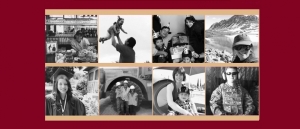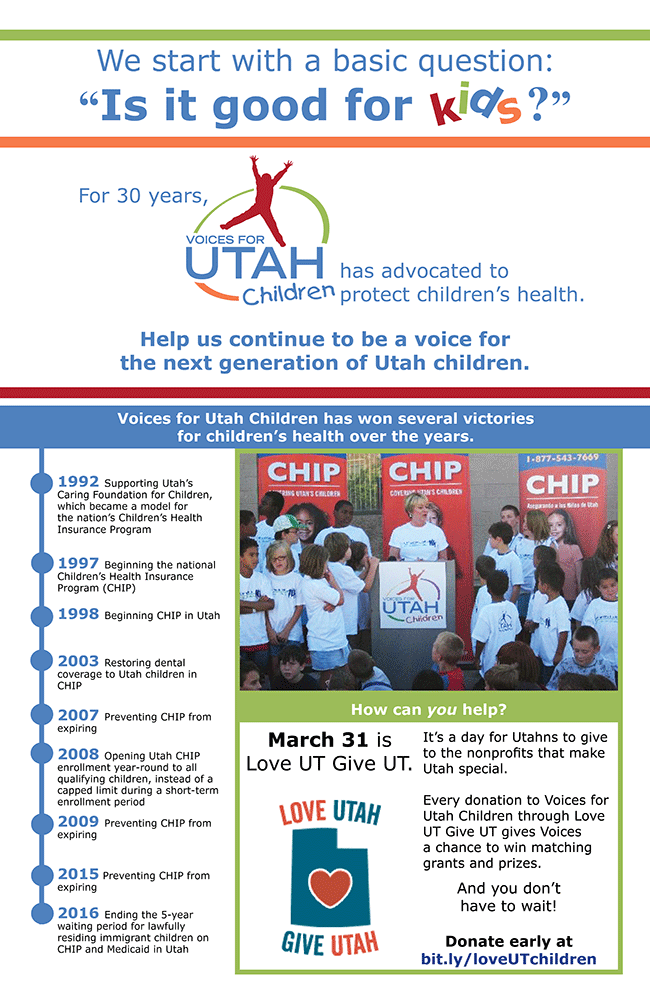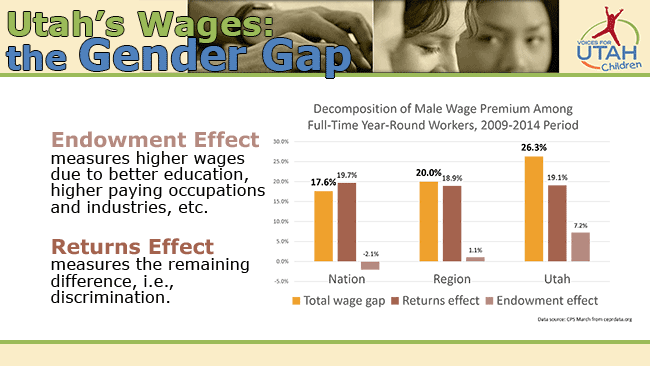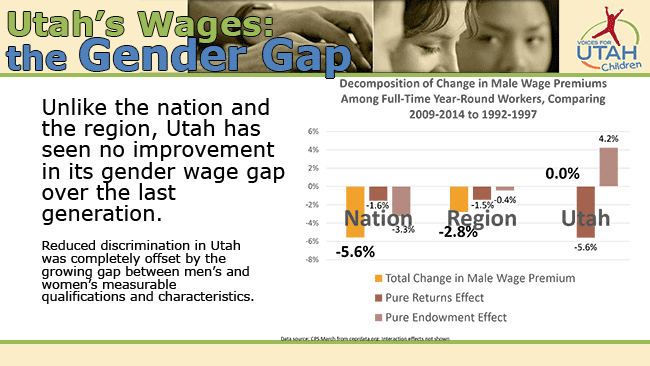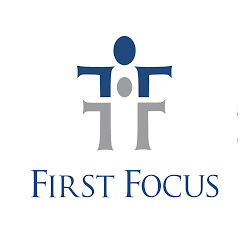Poverty
 The goal of the Working Families Benchmarking Project is to identify a variety of economic trends affecting working families across Utah, and then to examine those issues through a comparative lens, evaluating Utah’s overall progress by using a peer state as a benchmark. Colorado was chosen for this inaugural edition, in part for its geographic proximity to Utah — and thus relatively similar regional identity — as well as for its comparable rates of economic and population growth, demographics, and policy challenges.
The goal of the Working Families Benchmarking Project is to identify a variety of economic trends affecting working families across Utah, and then to examine those issues through a comparative lens, evaluating Utah’s overall progress by using a peer state as a benchmark. Colorado was chosen for this inaugural edition, in part for its geographic proximity to Utah — and thus relatively similar regional identity — as well as for its comparable rates of economic and population growth, demographics, and policy challenges.
Many existing economic comparison studies and rankings look at the economy as a whole or at its impact on specific sectors or on employers. This project seeks to augment those very useful comparisons by focusing on how the economy is experienced by middle and lower-income families. In particular, it is these families whose children are most at risk for not achieving their potential in school and later in the workplace and in society in general. Thus, how they experience the economy is of particular interest to Voices for Utah Children.
In Part I of the Project, we focus on economic opportunity. The dynamism, flexibility, and competitiveness of a state’s economy is a major contributor to economic opportunity, so we look at this topic through a wide range of metrics, from business climate and entrepreneurship rankings to educational attainment and demographic gaps.
Utah ranks ahead of Colorado in:
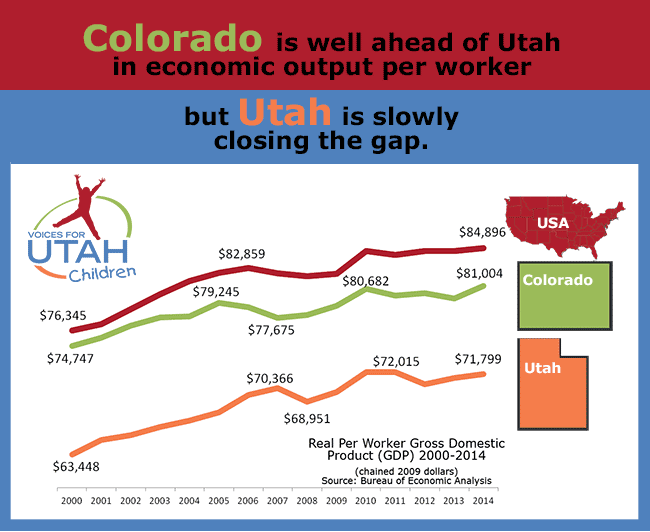 Business climate rankings
Business climate rankings- Gross Domestic Product (GDP) growth
- Lower unemployment
- Labor force participation
- Higher education system investment
- Referring fewer minority youth to the correctional system
- Reducing inequality and increasing social mobility
Colorado outpaces Utah in:
- Pre-K and kindergarten enrollment
- K-12 investment and performance
- Higher education attainment
- Workforce productivity
- Entrepreneurship
- The status of women in the economy
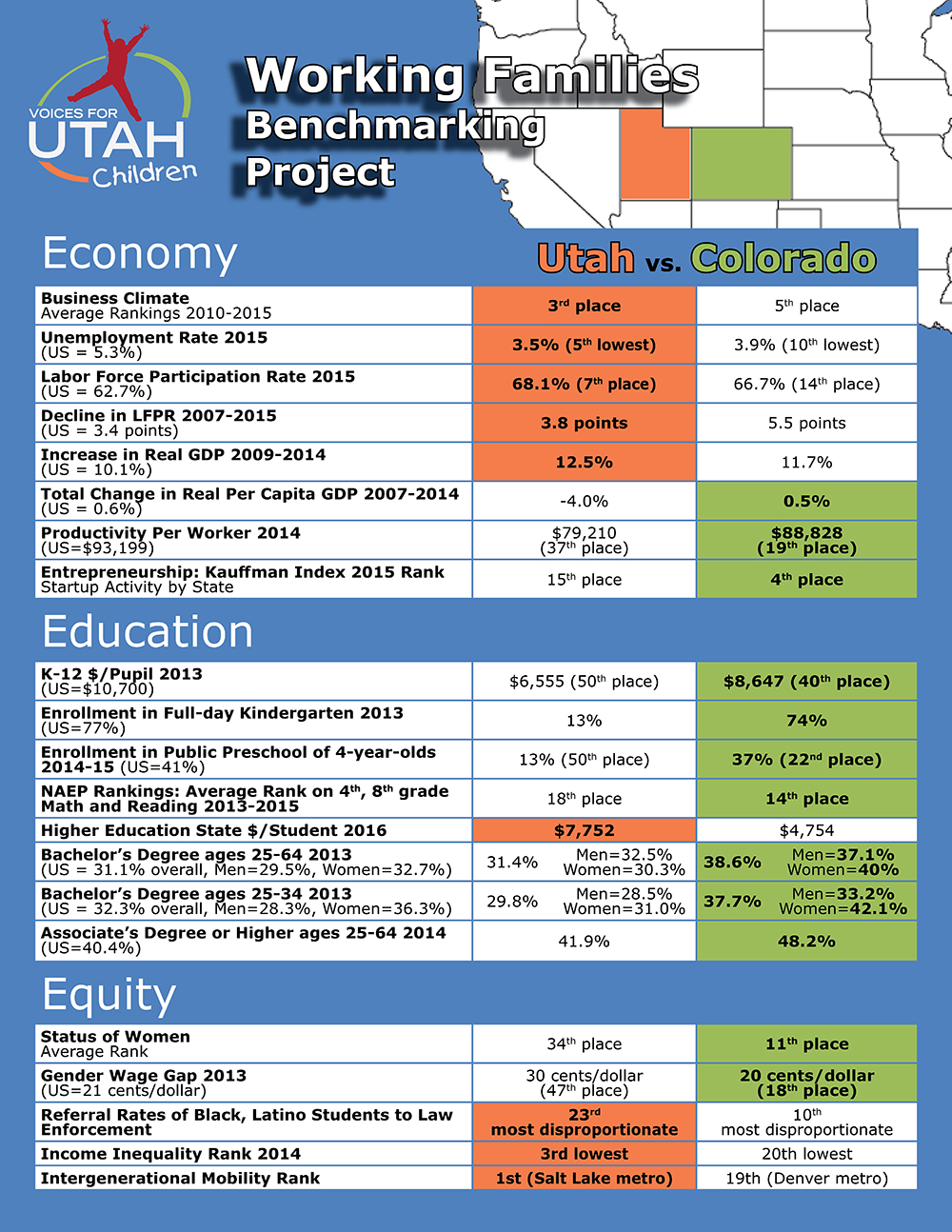
The gaps in educational attainment are perhaps the finding
of greatest concern for Utah’s long-term future.
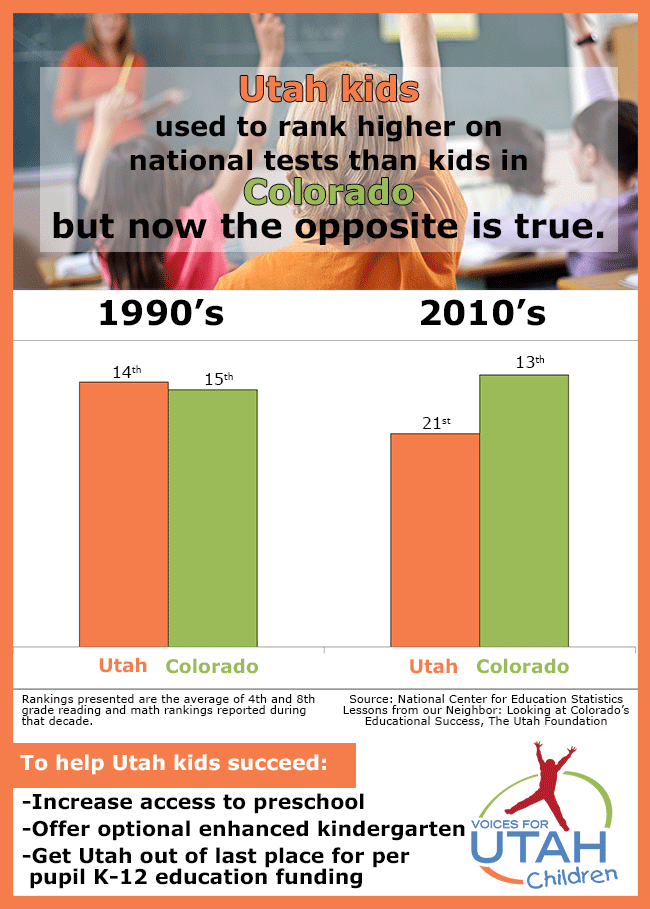
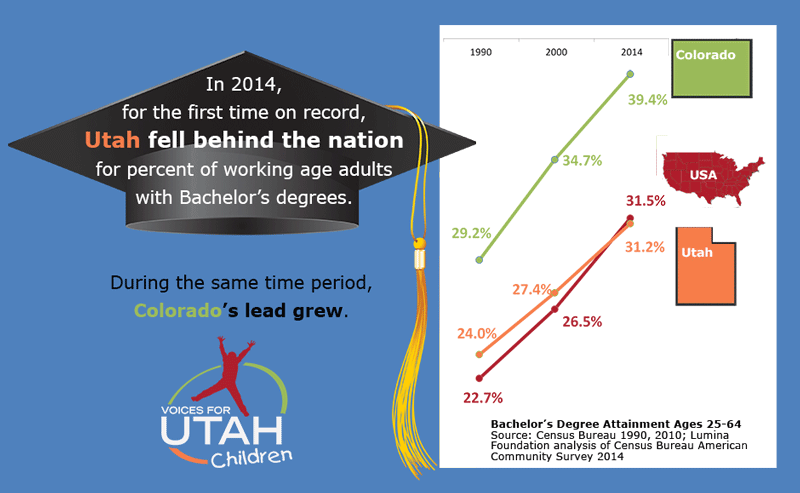
Since education is the foundation of opportunity and prosperity in a modern economy, Colorado’s success in educating its population and attracting highly educated migrants from other states may well hold lessons for Utah. Utah is wise to invest more that Colorado in higher education to attempt to make up this gap and should apply a similar lesson in the area of pre-K-12 funding.
As Utah builds on its many assets and grapples with its challenges in the years to come, we hope that this benchmarking project may contribute in a constructive way to the broader economic policy conversation among experts, policymakers, and the general public.
For more detailed information, see the complete printer-friendly report:
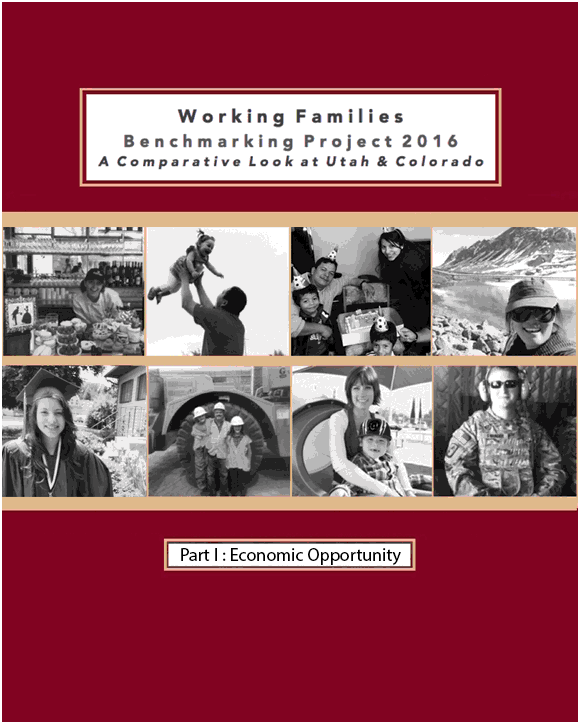
![]() Working Families Benchmarking Project Part One: Economic Opportunity
Working Families Benchmarking Project Part One: Economic Opportunity
These measures of economic opportunity also relate directly to the questions we address in Part 2: Standard of Living.
For 30 years now, Voices for Utah Children has called on our state, federal and local leaders to put children’s needs first. But the work is not done. The children of 30 years ago now have children of their own. Too many of these children are growing up in poverty, without access to healthcare or quality educational opportunities.
How can you be involved?
Make a tax-deductible donation to Voices for Utah Children—or join our Network with a monthly donation of $20 or more. Network membership includes complimentary admission to Network events with food, socializing, and opportunity to meet child advocacy experts. And don't forget to join our listserv to stay informed!
We look forward to the future of Voices for Utah Children and we hope you will be a part of our next 30 years.
Special thanks to American Express for sponsoring our 30th Anniversary Year. 
Racial and Ethnic Equity for Children in Utah
What We Learned from the 2016 Legislative Session
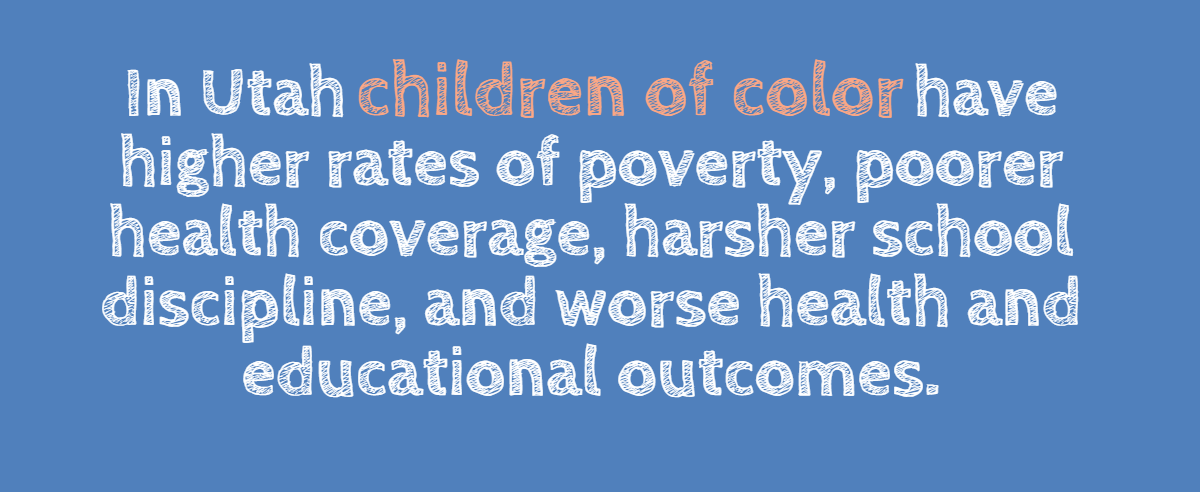
- Children of color in Utah face more poverty compared to non-Hispanic White children. As Utah becomes a more diverse state, children are affected by significant racial and ethnic disparities.
- The 2016 General Session failed to adequately meet the needs of children of color in Utah. There were some important steps forward but also missed opportunities and inaction.
- We saw gains for children’s preschool education, health coverage, school safety and criminal justice. There were missed opportunities to expand kindergarten, address our public defender crisis, expand health coverage for all low-income families and keep more families out of poverty.
- Going forward advocates have a responsibility to integrate an equity lens into our work and build coalitions that will strengthen opportunities for all families.
- Our Legislature, Governor and State Agencies should be more conscious of communities of color and low-income Utahns in their public policy decisions by reviewing the impact of bills and policies on all groups.
- In order to correct growing disparities and invest in Utah’s diverse future, lawmakers need to access data disaggregated by race and ethnicity and work with affected communities when developing policy.
Children’s Racial and Ethnic Equity in Utah
Was the 2016 Legislative Session Good for All Children?
Voices for Utah children starts with one basic question in our advocacy efforts: Is it good for kids?
For over 30 years we have been a statewide advocate, informing policymakers that they can and should act to keep children safe, healthy and help them succeed.
But as Utah’s demographic make-up changes, so too are the questions we have to ask. Is it good for all children, or just some children? Which children are making gains in our state while others are falling behind?
The number of Utah children who are non-White is growing. Since 2000, the percentage of children of color in Utah has grown from 17 to 25%. The Hispanic population is growing even faster. Hispanic children have grown from 11 to 17% of the total child population.
Unfortunately, there is a growing social and economic divide along racial and ethnic lines in Utah. Although Utah is a welcoming state, with a prominent international population, there are disparities among our diverse populations. Families of color face higher poverty rates compared to their White, non-Hispanic counterparts. The median household income for White, non-Hispanic families is significantly higher than all other racial and ethnic groups. White children are two to three times less likely to live in extreme poverty. Endnote 1
As a result, children of color have worse health outcomes, lower educational attainment, and are more likely to face school discipline and be involved in the juvenile justice system. What can we do to reverse this trend and create a Utah where all children can thrive?
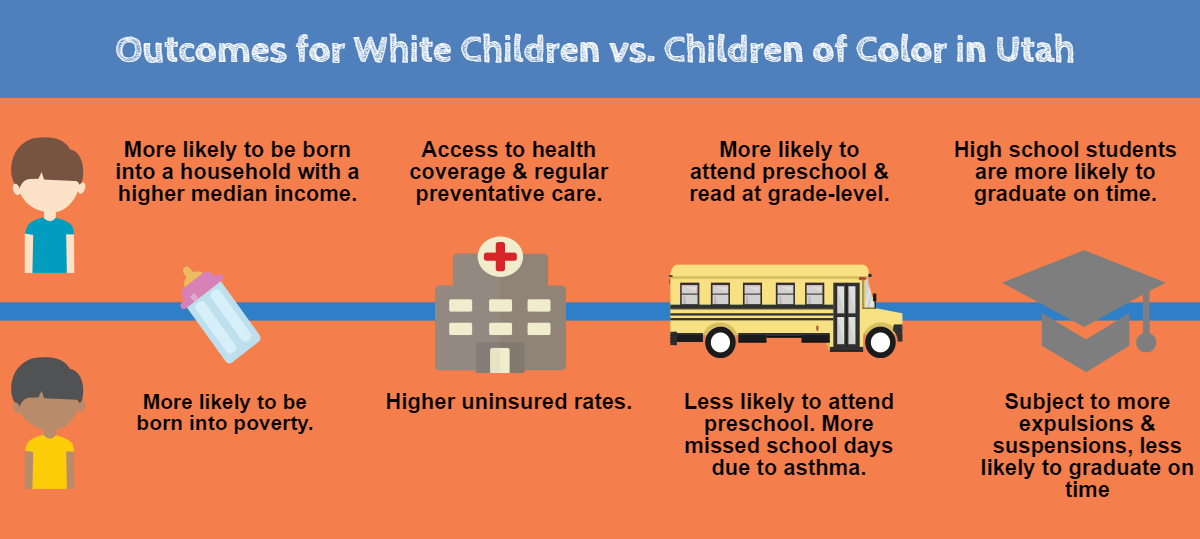
Public policies can help. Public policies play an important role in expanding opportunities for all children, strengthening our schools and public safety net. Endnote 2 But public policies can also create barriers for families. Laws can make it harder for some groups or communities to access care; funding cuts can reduce services. Or simply by maintaining the status quo, policies can perpetuate unnecessary barriers or hidden obstacles for families.
In the recent 2016 Legislative General Session, lawmakers introduced bills that expanded opportunities for children and families and others that created more barriers. At Voices for Utah Children, we look at these laws and ask not only, are they good for children? But also, are they good for everyone, or only some? And under what conditions? Endnote 3
In this report, we will reflect on the 2016 General Session and its potential impact on children from all racial and ethnic backgrounds. We examine legislation in four major issue areas: early childhood education, health, economic equity, and juvenile justice reform. Endnote 4 Using data which is disaggregated by race and ethnicity, this report will consider legislation that expands opportunity for children and youth, as well as missed opportunities for change.
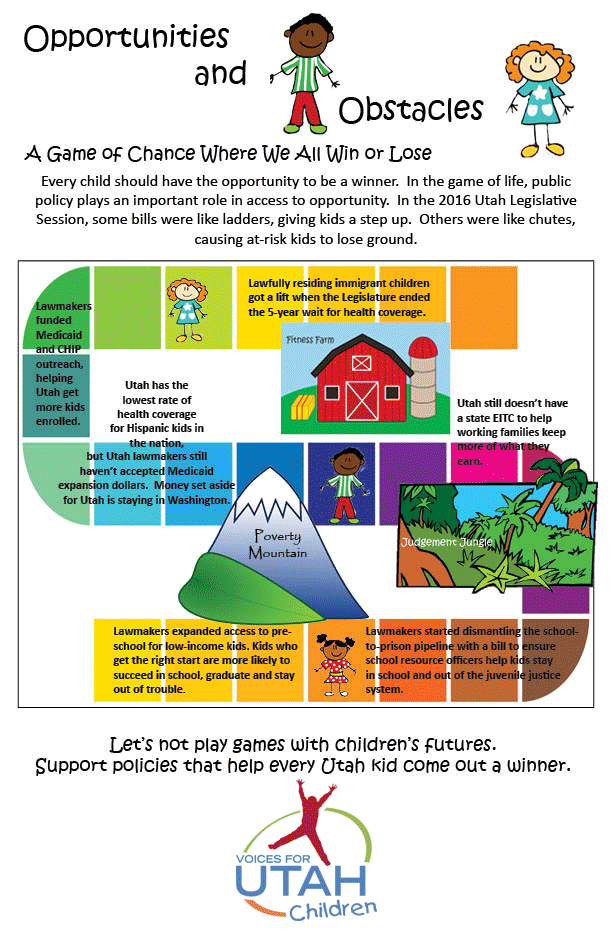
Early Childhood Education
Expanding Opportunities for High-Quality Preschool Programs
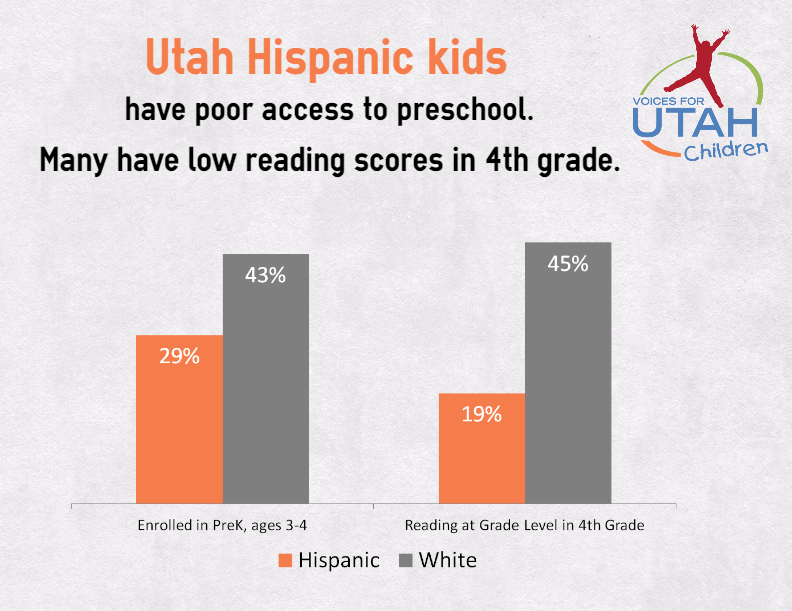
Early education opportunities can reduce racial and ethnic disparities. High-quality preschool helps children gain valuable cognitive, social, emotional and academic skills. Endnote 5 But with an attendance rate of 40%, Utah has one of the lowest rates of preschool attendance and the rate is even lower among children of color. Only 29% of Hispanic children ages 3 - 4 are attending preschool, compared to 43% of White, non-Hispanic children. One factor driving this discrepancy is that there are not enough affordable, quality preschools, especially in high-needs communities.
The Utah Legislature took steps to address this problem through SB 101, which makes more affordable, high-quality preschool slots available. SB 101 creates a grant program to expand high-quality preschool programs for at-risk children. It also provides scholarships for children who have been identified as living in intergenerational poverty. SB 101 was funded through Temporary Assistance for Needy Families (TANF), which directs funds to low-income children. However, the racial and ethnic gap in school readiness may not be fully accounted for by income, as research shows. In the future, Utah needs more programs, and supporting data, which can examine gaps in school readiness between children of different backgrounds, and ways to address those gaps in high-quality preschool programs. Endnote 6
Missed Opportunity: Expanding Optional Extended-Day Kindergarten and Readiness Assessments
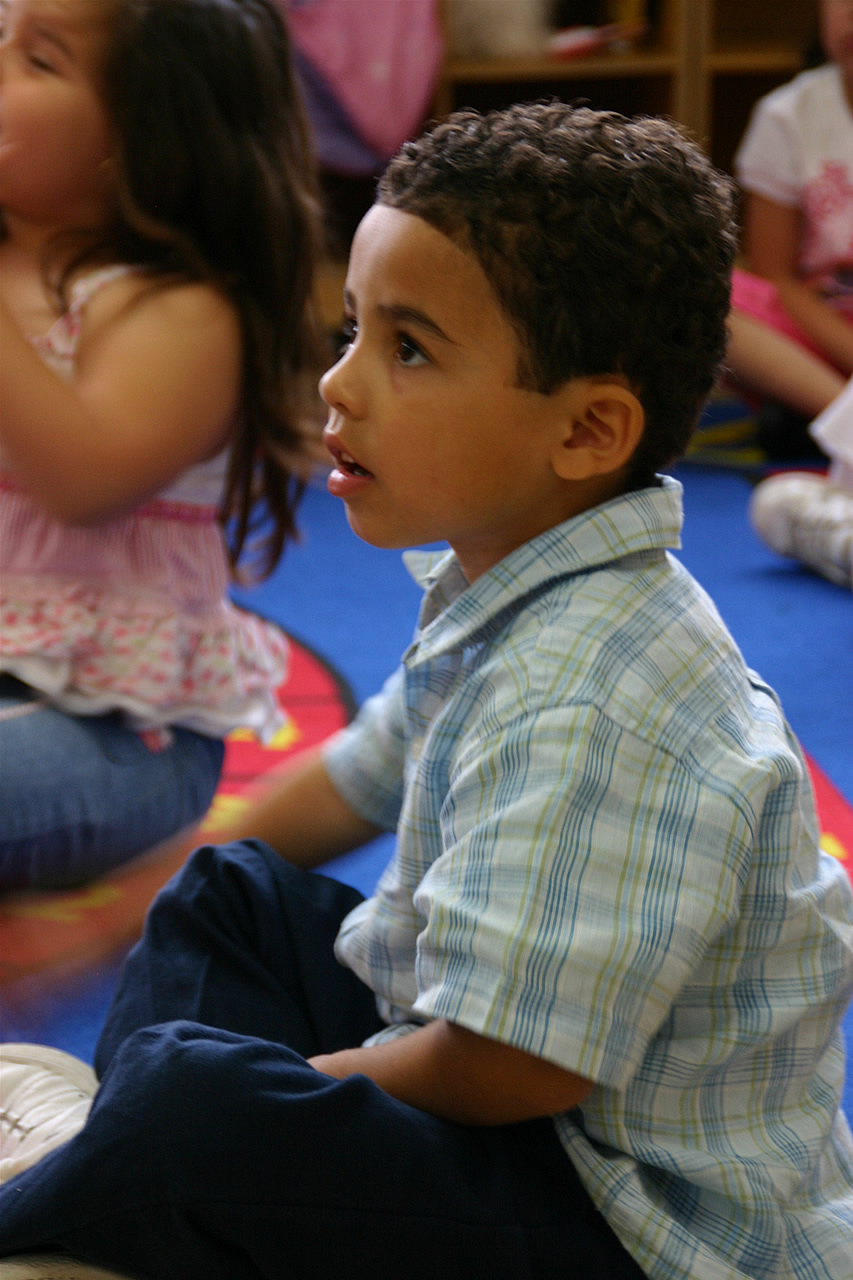 While SB 101 made significant gains for early education, the Legislature missed a critical opportunity to advance continuity in quality programming beyond preschool. HB 42 would have increased funding for quality optional extended-day kindergarten programs and created a statewide kindergarten entry and exit assessment tool.
While SB 101 made significant gains for early education, the Legislature missed a critical opportunity to advance continuity in quality programming beyond preschool. HB 42 would have increased funding for quality optional extended-day kindergarten programs and created a statewide kindergarten entry and exit assessment tool.
Full day kindergarten can help reduce racial and ethnic disparities in academic performance. In Utah, less than 15% of 5-year-olds participate in full day kindergarten programs. Endnote 7 Utah has one of the lowest rates of full day kindergarten participation in the nation. Overall there are not enough high-quality, full day, early education programs available in Utah, especially for at-risk children. This contributes to the achievement gap in later years. For example, 81% of Hispanic children are not reading at a proficient grade level by the 4th grade, compared to 55% of White, non-Hispanic children.
Moreover, Utah also lacks comprehensive data to understand children’s kindergarten readiness. By calling for a statewide entry and exit assessment tool, HB 42 would have allowed schools to better determine children’s kindergarten readiness. A statewide assessment can help educators develop appropriate interventions. Without sound, standardized statewide tools, we cannot adequately assist children most at risk of falling behind. Endnote 8
Juvenile Justice Reform
Expanding Opportunities: School Discipline and Juvenile Sentences
Nationwide, we see troubling racial and ethnic disparities in the juvenile justice system, and Utah is no exception. For example, Black children make up a disproportionate share of the juvenile justice system. Despite being only 1% of the total child population in Utah, Black youth make up 23% of the population in juvenile detention or correctional facilities.
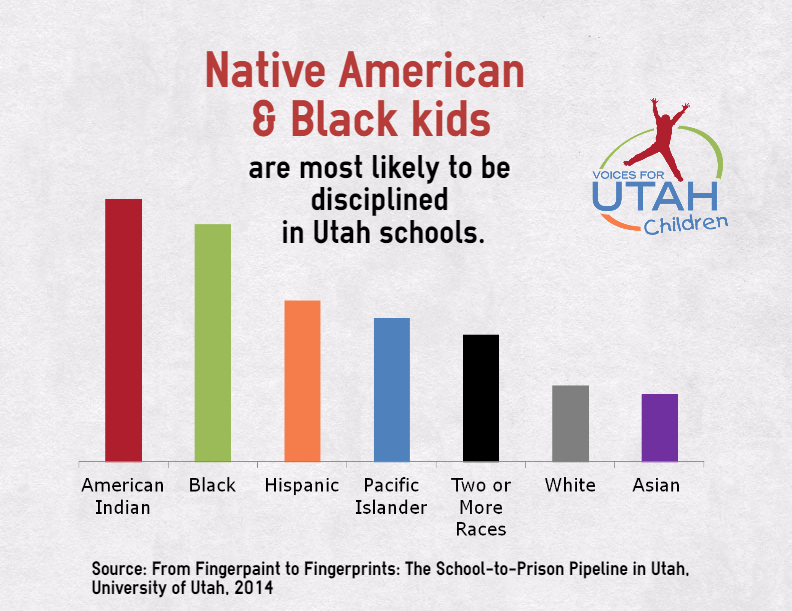
One significant factor leading to youth involvement in the juvenile justice system is school disciplinary action. There is a direct correlation between youth discipline in school and the likelihood that a child will become involved in the criminal justice system. Yet this too disproportionately impacts children along racial and ethnic lines. Children of color consistently face greater school disciplinary action compared to their White, non-Hispanic peers. Endnote 9 For example, American Indian and Black students are more likely to receive disciplinary action in Utah schools than other racial groups.
Given these findings, HB 460 is an encouraging step forward. HB 460 will provide training for school resource officers and school administrators. The law requires that the State Board of Education create a curriculum to help train officers in schools. HB 460 states that the training can include cultural awareness, resources for students exposed to trauma and restorative justice practices. Its aim is to prevent school disciplinary issues from escalating into larger, criminal justice issues. Appropriate training for school resource officers and administrators could reverse existing practices negatively affecting children of color.
Another promising step this legislative session is HB 405, which prohibits children from receiving life sentences without parole. HB 405 represents an important step in ensuring that the criminal justice system recognizes the unique needs of youth and children.
Missed Opportunities to Avoid Harsher Sentencing for Children of Color
There were also some significant missed opportunities for juvenile justice reform. In particular, SB 155 failed to address the crisis of public defenders in Utah. The law proposes to further study the problem and offers small county-level grants for adult indigent defense. While important, however, this will not help youth. All adults and children have the right to counsel if charged with a crime that might lead to jail, but Utah has failed to fulfill this Constitutional requirement. If a child does not have adequate access to a defense attorney, he or she could receive a harsher sentence. Low-income children of color are more likely to find themselves in the criminal justice system, and therefore more likely to experience harsher sentencing. The ‘school to prison pipeline’ in Utah is fueling some of our most alarming racial and ethnic inequities. We need systems committed to addressing these disparities and helping all children succeed.
Economic Equity
Missed Opportunities to Restore Funds for Public Programs
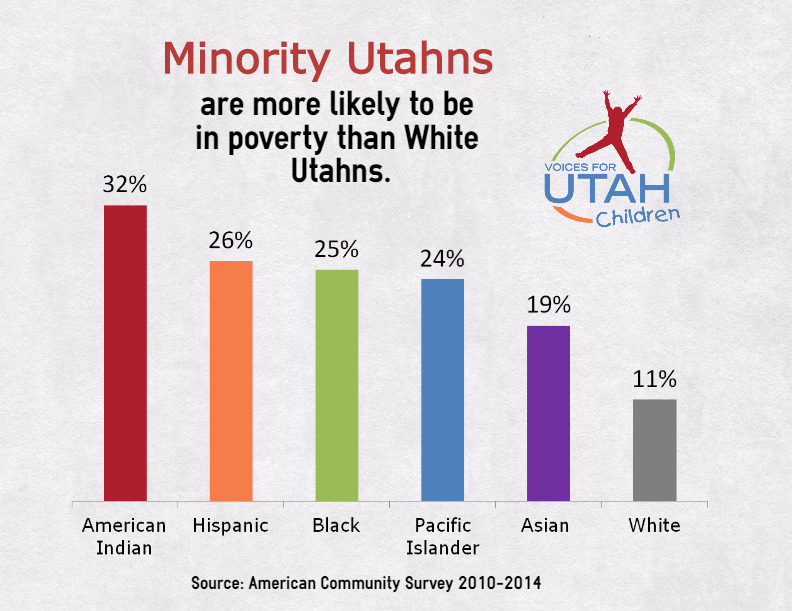
Families of color face higher poverty rates. Although Hispanic children make up only 17% of the total child population, they represent at least 39% of children living in poverty. Among Hispanic children, 31% live below the poverty threshold compared to 8% of non-Hispanic Whites. From the data available by racial and ethnic categories, we know that poverty in Utah is not experienced equally among all racial and ethnic groups.
What can our public policies do to help all Utahns? As a starting point, we need to ensure that there are enough public dollars available in our General Fund for the programs and services proven to help people achieve independence, meet their families’ needs, and move out of poverty. According to the Utah Foundation, public revenues in Utah are at a multi-decade low due to tax cuts enacted over the past decade. The 2016 Legislature failed to pass legislation that would have restored revenues. Instead, the 2016 Legislature focused its attention on several tax cutting measures, passing HB 61 to reduce corporate income taxes by about $3 million annually and coming close to passing HB 180 to expand a business sales tax exemption by $83 million annually.
Even as legislators give serious consideration to tax cuts that reduce funds available for education, health care, and initiatives that help families work their way out of poverty, the practice of earmarking – permanently diverting General Fund revenues to the Transportation Fund to avoid allowing transportation revenue sources like the gas tax to keep up with inflation – continues nearly unabated. Even though the Legislature’s own Tax Review Commission recommended eliminating almost all existing earmarks, the only proposal that passed this year was a compromise bill that restores about 4% of earmarks to the General Fund, while at the same time more deeply entrenching the earmarking phenomenon by redirecting transportation earmarks for water infrastructure instead.
Missed Opportunities to Help Utah Families Work Their Way Out of Poverty
Despite continued advocacy, there was no legislation in the 2016 session for a state-level Earned Income Tax Credit (EITC). The EITC is a policy proven to help millions of U.S. working families stay out of poverty. National data show that the EITC can help mitigate racial and ethnic disparities; almost half of all EITC-eligible households were headed by racial or ethnic minorities. Endnote 10 Families of color are more likely to be eligible for, and greatly benefit from, the EITC. A state-level tax credit for working families in Utah would keep even more families out of poverty.
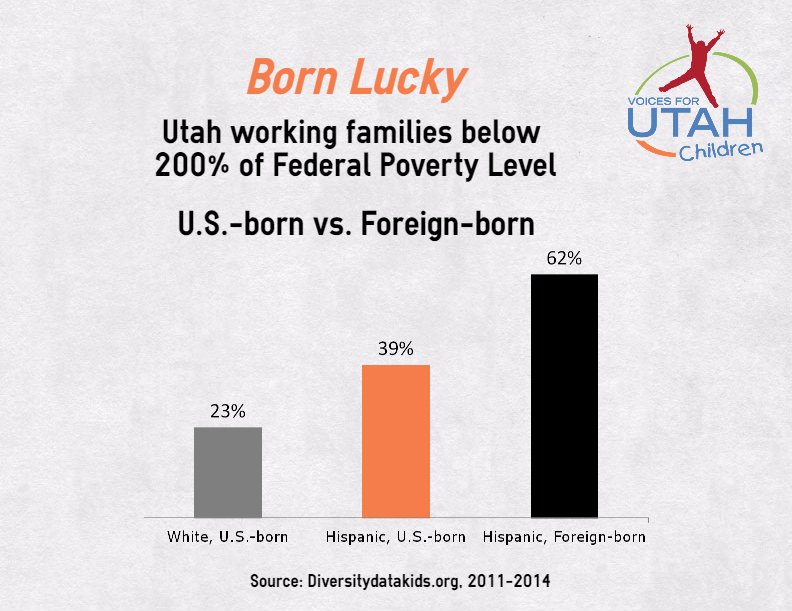 Paid leave was yet another missed opportunity to help families stay out of poverty. Many families do not have access to unpaid leave, and many who do have access are unable to afford it. The 2016 Legislature considered HB 188, which would have provided paid family leave for eligible executive branch agency employees. Families in the executive branch, which includes state divisions, departments and higher education systems, would be able to take leave, without losing pay. The topic will be further studied by the Legislature during the 2016 Interim.
Paid leave was yet another missed opportunity to help families stay out of poverty. Many families do not have access to unpaid leave, and many who do have access are unable to afford it. The 2016 Legislature considered HB 188, which would have provided paid family leave for eligible executive branch agency employees. Families in the executive branch, which includes state divisions, departments and higher education systems, would be able to take leave, without losing pay. The topic will be further studied by the Legislature during the 2016 Interim.
White, non-Hispanic parents in Utah are more likely to be eligible and financially able to take unpaid leave than other families. Discrepancies in family leave policies take the greatest toll on foreign-born parents of color: 20% of Hispanic foreign-born parents are both eligible and can afford unpaid leave, compared to 31% of White foreign-born parents. Among U.S.-born parents, 33% of Hispanic parents and 37% of White parents can afford to take unpaid leave. Endnote 11 Parents who are ineligible or cannot afford leave are at risk of losing pay--or their job-- when they stay home to care for their child.
Health
Expanded Opportunities for Children’s Coverage
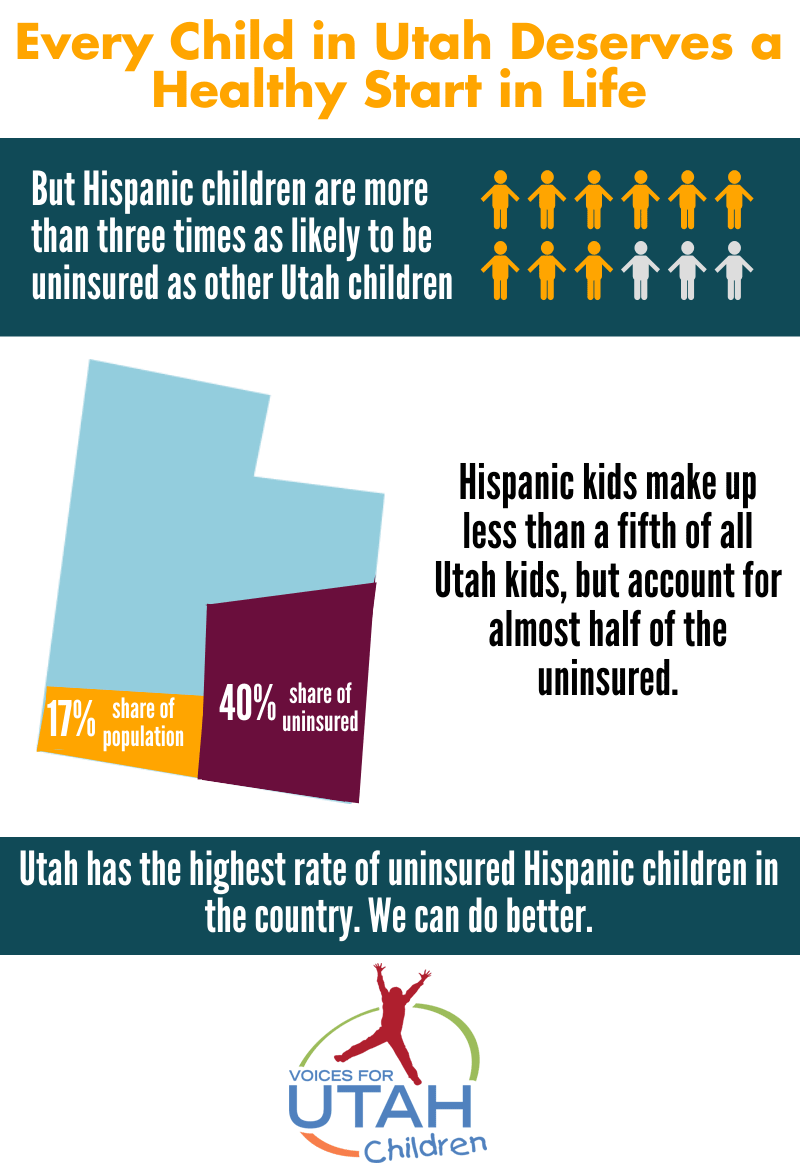
Utah has the highest rate of uninsured Hispanic children in the nation. Utah’s uninsured rate for Hispanic children is nearly two and a half times the national rate; it is higher than the rate in every other state and the District of Columbia. Children’s health coverage is the critical foundation for all children to get the care they need to achieve optimal health.
The 2016 Legislature removed the 5-year waiting period for legal immigrant children to receive CHIP or Medicaid. Appropriations bill HB 2 included intent language directing the Department of Health to enroll children as soon as they qualify. Previously, legal immigrant children were subject to a waiting period before they could receive CHIP or Medicaid. Eligible children include legal permanent residents and some additional immigration categories, although undocumented children are not included. The policy change will mean hundreds of children can get coverage. Five years is too long for children to wait.
In addition, the 2016 Legislature allocated $25,000 in one-time outreach funding to help enroll more children in CHIP or Medicaid. The Department of Health’s outreach budget was eliminated in 2010. The funding, allocated to the Department of Health, will be matched by federal dollars to total $50,000 and can be used to reach more Hispanic children.
The Legislature also directed the Department of Health to examine barriers to children’s coverage, including ‘churn’ or a frequent pattern of disenrollment and then re-enrollment from Medicaid. Children may lose Medicaid coverage because of fluctuations in their family’s income. Hispanic children are more likely to experience churn because of a change in their family’s temporary income status. At least 31% of Hispanic children have parents who lack year-round employment, compared to 18% of White children. The Department of Health’s study on churn could help reduce disruptions in children’s coverage and care.
Missed Opportunities: Expanding Coverage for All Parents
The 2016 Utah Legislature took first steps to cover more Utahns caught in the insurance coverage gap. HB 437 changed Medicaid eligibility to cover an estimated 4,000 additional parents, effectively raising the eligibility ceiling for parents with children up to 60% of the Federal Poverty Level. Unfortunately, the Legislature rejected more comprehensive bills that would fully close the coverage gap. As a result, thousands of working parents are still left without health insurance. Over one-quarter of the parents who would benefit from a full Medicaid expansion plan are Hispanic. When parents have insurance they are better able to care for their children. In addition, when parents have coverage, they bring their children along; enrollment numbers for children go up when parents have health coverage. Coverage for parents helps the whole family.
Recommendations Going Forward
Different communities may need different resources
to achieve similar outcomes.
The 2016 Legislative Session expanded opportunities for some children, but there were also many missed opportunities to improve the lives of children from all racial and ethnic backgrounds. These initial steps, while important, still leave much work ahead. Endnote 12
Across every issue area reviewed, we found significant social, economic, and health disparities affecting children of color. Utah laws and policies do not adequately address the growing diversity of our state. The face of Utah’s most vulnerable is changing. We need laws that embrace our diverse future.
This report is both a reflection of our own advocacy practices, as well as a call to action for lawmakers.
As advocates, we have a responsibility to integrate a lens of racial and ethnic equity into our own work and build coalitions that will strengthen opportunities for all families.
Together with community partners, we hope to contribute to a growing dialogue about racial and ethnic equity in the coming year and to advance policies that can help reduce disparities.
Our lawmakers also have a responsibility to create a more equitable Utah. To secure a future that is safe and healthy for all children, we call on our Legislature, Governor and State Agencies to:
- Work with coalitions and affected communities.
Ensure that those most affected are actively involved in developing policies. To create sustainable solutions, families from all communities must be consulted, engaged and able to meaningfully participate in the policy process. - Collect, disaggregate and disseminate data by race and ethnicity.
Our policymakers need access to the best data and analyses. Too often population measures of children’s well-being are not disaggregated by race or ethnicity. Several state-level initiatives have already begun to make progress in this area. We need to expand these efforts so we can track progress and find solutions. Without disaggregated data, we have an incomplete picture of the needs and outcomes affecting all Utah children. - Review the racial and ethnic impact of public policies.
Our lawmakers and policymakers should review the impact of proposed policies on different racial and ethnic groups. Racial and ethnic impact assessment tools can highlight which groups benefit, and under what conditions. These targeted measures can correct disparities and help our legislators make informed decisions for all communities in Utah.
Printer-friendly version:
![]() Racial and Ethnic Equity for Children in Utah: What We Learned from the 2016 Legislative Session
Racial and Ethnic Equity for Children in Utah: What We Learned from the 2016 Legislative Session
1. Unless otherwise noted, data and indicators are from the national Kids Count Data Center: http://datacenter.kidscount.org/data#UT/2/0/char/0
2. Arkansas Advocates for Children and Families. (2015) “Missing the Mark: Race Equity and Missed Opportunity in the 2015 Session. Research Brief July 2015. Available at: http://www.aradvocates.org/publications/missing-the-mark-race-equity-and-missed-opportunities-in-the-2015-session/
3. DiversityDataKids.org. “What is Research Evidence and Why Does It Matter for Equity?” The Heller School for Social Policy and Management at Brandeis University. Available at: http://www.diversitydatakids.org/files/Policy/Head%20Start/Research%20Evidence/What%20is%20Research%20Evidence.pdf
4. Voices for Utah Children focused on these major issue areas during the 2016 Legislative Session. This report does not represent a comprehensive review of all legislation.
5. Heckman, J. J. (2011) "The American Family in Black & White: A Post-Racial Strategy for Improving Skills to Promote Equality." Daedalus, 140(2), 70-89.
6. Magnuson, K. A., & Duncan, G. J. (2005) "Can Family Socioeconomic Resources Account for Racial and Ethnic Test Score Gaps?" The future of children, 15(1), 35-54.
7. Utah Foundation. (2015) “Lessons From Our Neighbor: Learning From Colorado’s Educational Success.” Research Report 731, July 2015. Available at: http://www.utahfoundation.org/uploads/rr731.pdf
8. Utah Department of Workforce Services. (2015) “Fourth Annual Report on Intergenerational Poverty, Welfare Dependency and the Use of Public Assistance.” Utah Intergenerational Welfare Reform Commission Annual Report. Available at: https://jobs.utah.gov/edo/intergenerational/igp15.pdf
9. University of Utah S. J. Quinney College of Law. (2014) “From Fingerpaints to Fingerprints: The School-to-Prison Pipeline in Utah.” Public Policy Clinic Report. Available at: https://www.law.utah.edu/news/from-fingerpaint-to-fingerprints-the-school-to-prison-pipeline-in-utah/
10. Holt, Steve. (2006) “The Earned Income Tax Credit at 30: What We Know.” Research Brief February 2006. Washington DC: The Brookings Institution Metropolitan Policy Program. Available at: http://www.brookings.edu/research/reports/2006/02/childrenfamilies-holt
11. DiversityDataKids.org. (2014) “Working Parents Who Are Eligible For and Can Afford FMLA Unpaid Leave.” Utah Map. Available at: http://www.diversitydatakids.org/data/map/510/working-parents-who-are-eligible-for-and-can-afford-fmla-unpaid-leave-share/#loct=2&cat=28,24&tf=17
12. The following were references and models for this report: Arkansas Advocates for Children and Families. “Missing the Mark: Race Equity and Missed Opportunity in the 2015 Session.” Available at: http://www.aradvocates.org/publications/missing-the-mark-race-equity-and-missed-opportunities-in-the-2015-session/; “Facing Race: The 2015 Oregon Racial Equity Legislative Report.” Available at: https://facingraceoregondotorg.files.wordpress.com/2016/01/2015facingraceweb.pdf; “Strong Families New Mexico 2015 Legislative Report Card.” Available at: http://strongfamiliesmovement.org/nm-reportcard
For 30 years now, Voices for Utah Children has called on our state, federal and local leaders to put children’s needs first. But the work is not done. The children of 30 years ago now have children of their own. Too many of these children are growing up in poverty, without access to healthcare or quality educational opportunities.
How can you be involved?
Make a tax-deductible donation to Voices for Utah Children—or join our Network with a monthly donation of $20 or more. Network membership includes complimentary admission to Network events with food, socializing, and opportunity to meet child advocacy experts. And don't forget to join our listserv to stay informed!
We look forward to the future of Voices for Utah Children and we hope you will be a part of our next 30 years.
Special thanks to American Express for sponsoring our 30th Anniversary Year. 
Mass Incarceration of Parents Hurts Kids
The latest Annie E. Casey Foundation report, A Shared Sentence: the devastating toll of parental incarceration on kids, families and communities, states that “the most powerful step, by far” to protect the children of parents in the justice system “is to reduce our nation’s overreliance on incarceration.” Having an incarcerated parent is a traumatic experience for a child with long-lasting health effects and often leads to poverty, which is also a threat to child well-being.
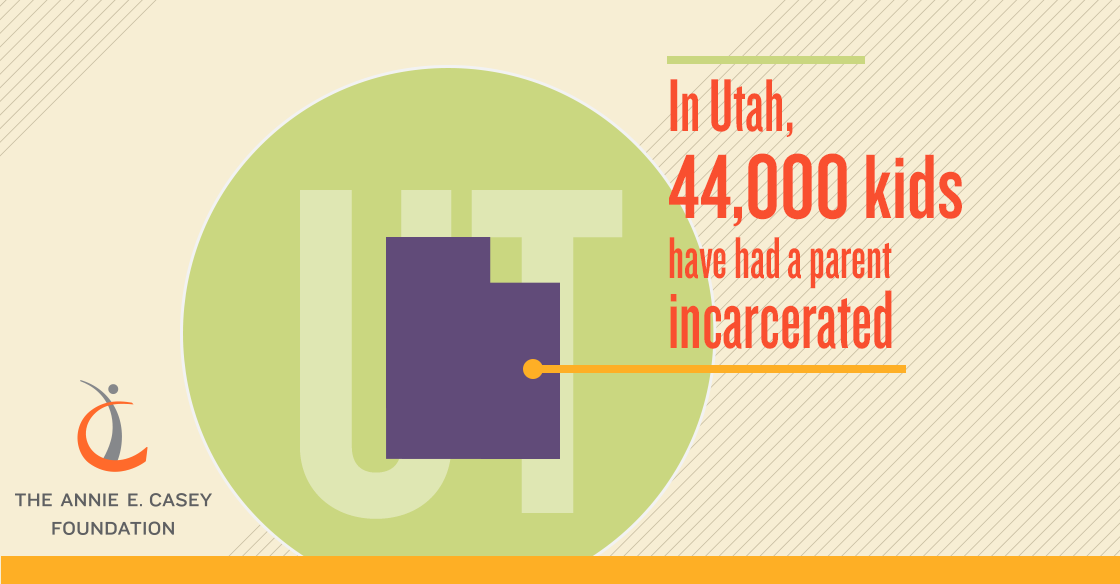 The report demonstrates that during the eighties and nineties, the number of kids with a father in prison or jail rose by 500%. Rising incarceration rates thwarted an opportunity to reduce the U.S. poverty rate by 20%; researchers point to increased incarceration as the factor that kept poverty rates from dropping.
The report demonstrates that during the eighties and nineties, the number of kids with a father in prison or jail rose by 500%. Rising incarceration rates thwarted an opportunity to reduce the U.S. poverty rate by 20%; researchers point to increased incarceration as the factor that kept poverty rates from dropping.
“While momentum for criminal justice reform continues to build, we know progress will take time. But we also know children can’t wait—nor can we as a nation afford to let them and their parents flounder, perpetuating poverty from one generation to the next.”
–Annie E. Casey Foundation
“There is no question that our country’s practice of mass incarceration is flawed, costly and in need of change,” states the report. The report lists several alternatives to overusing prisons and jails:
- Shorter sentences for nonviolent crimes (The majority of incarcerated persons are serving time for nonviolent offenses.)
- Alternative punishments to jail and prison for nonviolent offenders
- Not imprisoning people awaiting trial who can’t afford bail (People imprisoned while waiting for trial can lose their jobs, child care or homes even if they are absolved of wrongdoing.)
Another recent report released by the Sentencing Project, Fewer Prisoners, Less Crime: A Tale of Three States, profiled three states that dramatically reduced their prison populations in recent years and found that “during their period of decarceration, violent crime rates fell at a greater rate in these three states than they did nationwide.” The report concludes, “At least in three states we now know that the prison population can be reduced by about 25% with little or no adverse effect on public safety.”
Perhaps Utah should take a long look at states that are finding success in reducing the prison population. Do we also have an opportunity to improve outcomes for children and their families by reducing our prison population?
For 30 years now, Voices for Utah Children has called on our state, federal and local leaders to put children’s needs first. But the work is not done. The children of 30 years ago now have children of their own. Too many of these children are growing up in poverty, without access to healthcare or quality educational opportunities.
How can you be involved?
Make a tax-deductible donation to Voices for Utah Children—or join our Network with a monthly donation of $20 or more. Network membership includes complimentary admission to Network events with food, socializing, and opportunity to meet child advocacy experts. And don't forget to join our listserv to stay informed!
We look forward to the future of Voices for Utah Children and we hope you will be a part of our next 30 years.
Special thanks to American Express for sponsoring our 30th Anniversary Year. 
Love UT Give UT is Thursday, March 31 and we need your help!
Donate Now
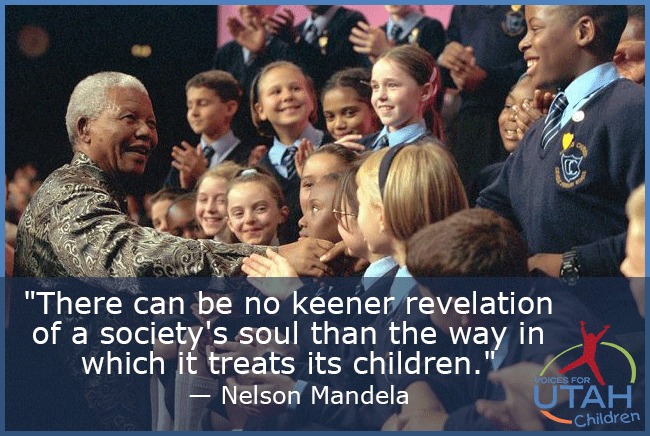 Public policies affect children—but children don’t vote. At Voices for Utah Children, we raise our voices on behalf of children, informing policymakers that government can and should act to keep kids safe and help them succeed.
Public policies affect children—but children don’t vote. At Voices for Utah Children, we raise our voices on behalf of children, informing policymakers that government can and should act to keep kids safe and help them succeed.
Voices for Utah Children actively seeks grant money from children’s foundations to support our research and educational efforts, but most grant funding cannot be used for lobbying. Voices for Utah Children needs donations from community members to fund staff time at Capitol Hill—where we put our knowledge about children into action by supporting legislation that protects and invests in children.
Your support was crucial to the successful legislative session we just completed. Because of your donations, Voices for Utah Children won important victories benefiting Utah children and families:
- Additional money for quality preschool for 4,000 children;
- Removal of the 5-year waiting period for legal immigrant children to help 1,000 children enroll in CHIP and Medicaid;
- Expanded Medicaid coverage to 3,800 parents in poverty;
- The first CHIP and Medicaid outreach funding since 2007 to support the Department of Health’s efforts to reach and enroll eligible Hispanic families.
Utah’s statewide day of giving is Love UT Give UT on March 31. Your tax-deductible donation to Voices for Utah Children goes even further during the Love UT Give UT campaign. Generous donors may match your donation and if Voices for Utah Children is among the Utah charities that receive the most donations of at least $10 each from different individual supporters, we could win up to $10,000 to support our mission.
In this video, a Utah child explains some of the victories Voices for Utah Children has won for Utah kids. Help us keep speaking out for the next generation of Utah kids. Donate by March 31 to Voices for Utah Children through Love UT Give UT at http://bit.ly/loveUTchildren
Video: A 10-year-old explains why you should support Voices for Utah Children
Donate Now
 March 31, 2016 is Love UT Give UT!
March 31, 2016 is Love UT Give UT!
It’s a day for Utahns to give to the nonprofits that make Utah special. Every donation to Voices for Utah Children through Love UT Give UT gives Voices a chance to win matching grants and prizes.
And you don't have to wait! Donate now at http://bit.ly/loveUTchildren.
For 30 years now, Voices for Utah Children has called on our state, federal and local leaders to put children’s needs first. But the work is not done. The children of 30 years ago now have children of their own. Too many of these children are growing up in poverty, without access to healthcare or quality educational opportunities.
How can you be involved?
Make a tax-deductible donation to Voices for Utah Children—or join our Network with a monthly donation of $20 or more. Network membership includes complimentary admission to Network events with food, socializing, and opportunity to meet child advocacy experts. And don't forget to join our listserv to stay informed!
We look forward to the future of Voices for Utah Children and we hope you will be a part of our next 30 years.
Special thanks to American Express for sponsoring our 30th Anniversary Year. 
Last year, we brought you a version of The Good, The Bad and The Ugly for our legislative overview. For this year’s health policy round-up, we’re relying on another classic Western, The Magnificent Seven, to review the seven main children’s health issues of the session. Not all seven topics made it to the end of the session (much like the gunslingers in the movie). But all of them put up a good fight.
1. Enrolling More Children in CHIP and Medicaid
Utah has one of the highest rates of uninsured children in the nation. We need to take the steps to help children and families enroll–and stay enrolled–in health coverage. There are 85,000 uninsured children in Utah. Even more concerning, the majority of uninsured children in the state are already eligible for health insurance coverage like CHIP or Medicaid but not enrolled.
Fortunately, some important steps were taken this session. The legislature allocated state funding to the Department of Health for CHIP and Medicaid outreach so that more families can learn about their coverage options. In addition, the legislature directed the Department of Health to study some of the barriers to children’s enrollment in CHIP and Medicaid and the fixes needed so more children have coverage. Some of the potential fixes include 12-month continuous eligibility for children on Medicaid, which would allow children to maintain coverage for one full year, even if families experience a change in income or family status. Finally, the legislature removed the five-year waiting period for legal immigrant children to receive CHIP and Medicaid. Immigrant children who would otherwise qualify for CHIP and Medicaid no longer have to wait five years to receive health coverage.
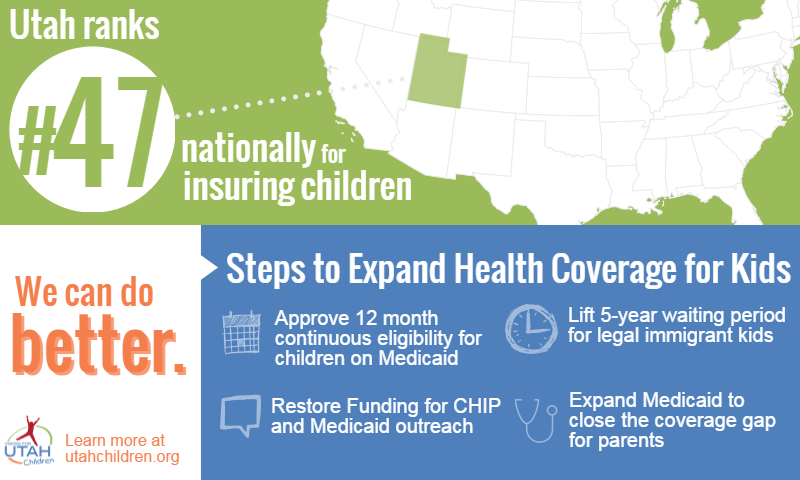
2. Health Coverage for Parents
Healthy parents = healthy children. When parents have insurance, they are better able to care for their children. In addition, when parents have coverage they bring their children along too. Enrollment numbers for children go up when parents have health coverage. Unfortunately there are tens of thousands of uninsured parents in Utah today. While the legislature did not close the coverage gap this session, it took important first steps. HB 437 (Rep Dunnigan R-Taylorsville) changed Medicaid eligibility to cover an estimated 3,800 additional parents, effectively raising the eligibility ceiling for parents with children up to 60% of Federal Poverty Level. More robust bills that did not become law, including SB 77 (Sen Gene Davis D-Salt Lake County), would have expanded Medicaid and closed the coverage gap. In addition, the legislature funded Primary Care Access Grants. These grants help many low-income families and individuals, especially in rural areas. These are important steps to take, but we need to continue on until all Utahns have access to comprehensive health coverage.
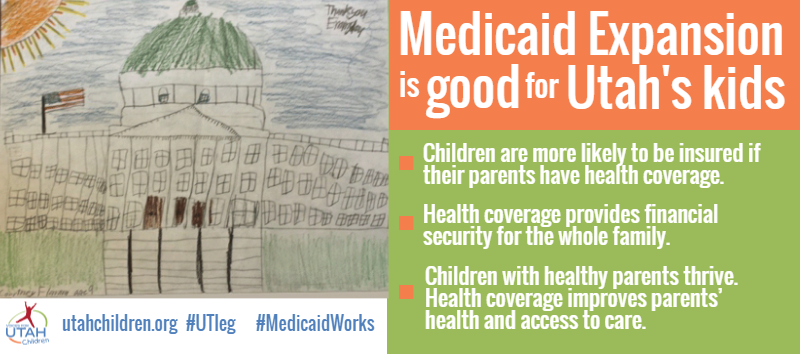
3. Reducing Health Disparities
Children of color are more likely to experience poor health outcomes compared to White children. Utah has the highest rate of uninsured Hispanic children in the nation. Hispanic children make up 17% of the population, but they make up 40% of the total uninsured population. As mentioned above, one win for the session was the elimination of the five-year waiting period for legal immigrant children. Legal permanent resident (LPR) children will soon be able to enroll in CHIP or Medicaid as soon as they qualify, without having to wait five years. At the request of the Governor’s budget, the legislature also allocated funding for Family Spirit, a home visiting program specifically for young Native American families in Utah. The program is a culturally-focused and strength-based approach for new parents and their children. These measures move our state in the right direction; but more work is needed. All children, regardless of their racial or ethnic background, should be able to access the care they need to achieve optimal health.
4. Disease Prevention and Health Promotion
The following public health policies were not enacted, although they would have saved the state money and improved children’s health:
Curtailing Youth Tobacco Use: HB 157 (Representative Kraig Powell R-Heber City) would have raised the age limit for tobacco use and HB 333 (Representative Paul Ray R-Clearfield) imposed an e-cigarette tax. These are important steps to prevent rising rates of e-cigarette use among youth in our state. Despite strong support, including active youth advocacy, both of these bills failed in committee.
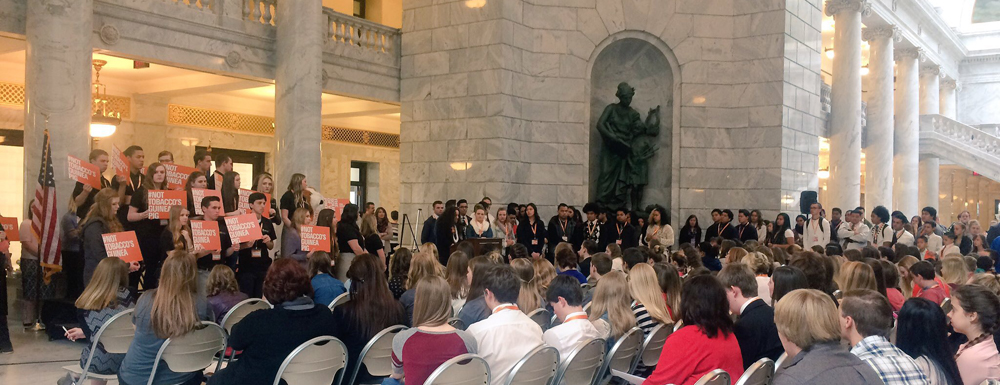
Information about Childhood Immunizations: Choosing not to vaccinate your child is a serious decision for one’s child and community. HB 221 (Rep Carol Spackman-Moss D-Salt Lake City) would have required parents who choose not to vaccinate to take a brief online training. The training would inform parents how to recognize the signs and symptoms of disease and learn what to do in the event of a disease outbreak in order to keep their child safe. The bill narrowly passed the House. However in the final days of the session, the Senate made amendments to the bill that undermined its intent. There was not adequate time to resolve these differences and the bill did not pass. As immunization rates in Utah decline, more children are at risk when disease outbreaks occur. This bill highlights the need for continued public health awareness, information and discussion so that all children in Utah can be safe.
Family planning: Representative King sponsored HB 246, Reproductive Health Amendments, that would have provided comprehensive sex education in schools. It also would have allowed more low-income families to receive comprehensive family planning services. This bill would have helped reduce rising rates of sexually transmitted infections by helping more teens make informed choices. However, controversies surrounding sex education kept this bill from advancing out of committee.
5. Services for Children with Special Healthcare Needs
Legislators increased some of the funding for children with special needs. The Baby Watch Early Intervention program received one-time funding to support its critical programs. Legislators including Sen. Luz Escamilla (D-Salt Lake City) and advocates worked tirelessly to make sure the programming could continue. As parents can testify, the Baby Watch Early Intervention program allows parents to receive the early support, assessment and coordination of care they need for their children. The legislature also funded additional slots and increased the caseload for the Medically Complex Children’s Waiver in the Medicaid Program. Additionally, in HB 2, the legislature also allocated funding for the children’s hearing aid pilot program account. In the future, more funds are needed for children with special health care needs, but the legislature took important measures to help more children and families.
6. Crisis Nurseries and Home Visiting for Under-Resourced Families
The Utah legislature allocated funding for families in crisis in HB 2. These funds include TANF funding for domestic violence shelters. It also includes some funding for crisis/respite nurseries under contract with the Division of Child and Family Services. Crisis nurseries play a vital role for families experiencing hardship. In addition, the legislature allocated funding to home visiting programs. The two evidence-based programs funded are Family Spirit and Parents as Teachers. Home visiting programs have been shown to improve the long and short term health outcome for new mothers and their children.
7. Maternal Health and Prenatal Services
The legislature considered several bills that address obstetric care for moms, including two bills that addressed midwifery services. HB 184 (Rep Spackman Moss) made technical changes to current midwifery practices. SB 108 (Sen Deirdre Henderson) removed certain restrictions on licensed birth centers to enable expanded services, despite some concerns from the despite some concerns from physician groups. Both HB 184 and SB 108 passed.
HB 246, Reproductive Health Amendments, also included a provision that would expand family planning services for low-income families that do not qualify for Medicaid. Since this bill failed in committee, it was a missed opportunity for the state to apply for a waiver to extend family planning services for women at 138% of Federal Poverty Level. The state would have received an enhanced federal matching rate for such services, making this a cost-effective policy change for the state. In addition, the provision would have helped individuals who fall in the coverage gap receive comprehensive family planning services.
Those are some of the “magnificent” seven health topics from the 2016 legislative session. For more information on any of the issues or bills mentioned, please contact Jessie Mandle. Voices for Utah Children will continue the fight this coming year so that all children in our state can achieve health and wellness.
 March 31, 2016 is Love UT Give UT!
March 31, 2016 is Love UT Give UT!
It’s a day for Utahns to give to the nonprofits that make Utah special. Every donation to Voices for Utah Children through Love UT Give UT gives Voices a chance to win matching grants and prizes.
And you don't have to wait! Donate now at http://bit.ly/loveUTchildren.
For 30 years now, Voices for Utah Children has called on our state, federal and local leaders to put children’s needs first. But the work is not done. The children of 30 years ago now have children of their own. Too many of these children are growing up in poverty, without access to healthcare or quality educational opportunities.
How can you be involved?
Make a tax-deductible donation to Voices for Utah Children—or join our Network with a monthly donation of $20 or more. Network membership includes complimentary admission to Network events with food, socializing, and opportunity to meet child advocacy experts. And don't forget to join our listserv to stay informed!
We look forward to the future of Voices for Utah Children and we hope you will be a part of our next 30 years.
Special thanks to American Express for sponsoring our 30th Anniversary Year. 
Help us keep protecting children's health with #loveUTgiveUT
 March 31, 2016 is Love UT Give UT!
March 31, 2016 is Love UT Give UT!
It’s a day for Utahns to give to the nonprofits that make Utah special. Every donation to Voices for Utah Children through Love UT Give UT gives Voices a chance to win matching grants and prizes.
And you don't have to wait! Donate now at http://bit.ly/loveUTchildren.
For 30 years now, Voices for Utah Children has called on our state, federal and local leaders to put children’s needs first. But the work is not done. The children of 30 years ago now have children of their own. Too many of these children are growing up in poverty, without access to healthcare or quality educational opportunities.
How can you be involved?
Make a tax-deductible donation to Voices for Utah Children—or join our Network with a monthly donation of $20 or more. Network membership includes complimentary admission to Network events with food, socializing, and opportunity to meet child advocacy experts. And don't forget to join our listserv to stay informed!
We look forward to the future of Voices for Utah Children and we hope you will be a part of our next 30 years.
Special thanks to American Express for sponsoring our 30th Anniversary Year. 
A Tale of Two Utahs: How do Urban and Rural Utah Measure Up?
 It is widely agreed that rural communities have a different set of issues than more urban communities. While all low-income families, regardless of where they live, need connections to support programs and access to economic opportunities, strategies that work in urban areas often cannot be applied to rural areas where social and economic programs are few and far between.
It is widely agreed that rural communities have a different set of issues than more urban communities. While all low-income families, regardless of where they live, need connections to support programs and access to economic opportunities, strategies that work in urban areas often cannot be applied to rural areas where social and economic programs are few and far between.
Because access to services is such an important issue in Utah’s rural areas, it is imperative that policymakers and service providers have a clear view of the problems facing rural communities. In Voices for Utah Children’s annual publication Measures of Child Well-Being in Utah, a variety of child well-being indicators are presented at the county level. These indicators cover important milestones in areas such as economic security, education, and health.
This edition of Data Links explores several of the indicators annually presented in Measures to see how much or if child well-being differs in rural communities as compared to urban communities.
DEFINING URBAN AND RURAL
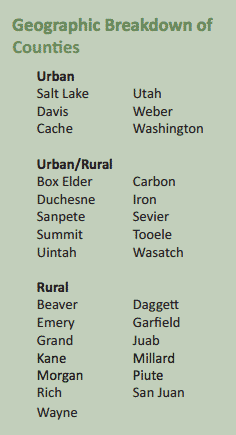 There are a myriad of definitions for “urban” and “rural” from a variety of sources. For the purposes of this report we have chosen to use three categories based on the American Community Survey’s three breakdowns for the one year, three year and five year estimates:
There are a myriad of definitions for “urban” and “rural” from a variety of sources. For the purposes of this report we have chosen to use three categories based on the American Community Survey’s three breakdowns for the one year, three year and five year estimates:
Urban Areas - Areas with populations of 65,000+
Urban/Rural - Areas with populations of 64,999 to 20,000
Rural Areas - Areas of population 20,000 and under
Counties included in each area are indicated in the box to the right.
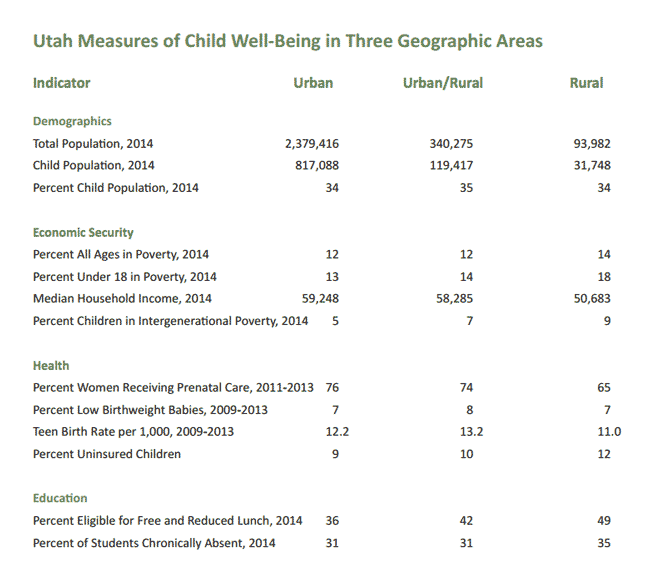

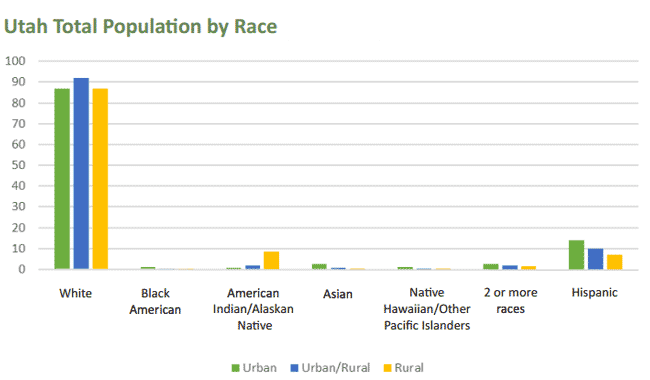
CONCLUSION
This data brief started out by saying it is widely agreed that rural communities have a different set of issues than urban communities. Access to services is difficult for a variety of reasons including lack of transportation and a lack of service providers. When there are no providers in town and individuals must wait on availability, scheduling can become a problem. In some cases where an individual has no family leave policy, traveling to a provider can mean missed wages. Child well-being indicators for children in rural Utah are, in general, slightly worse than those in urban areas. This makes all the above issues even more pressing and an area of concern that needs to be addressed.
“In urban areas, questions of access to care often revolve around whether all segments of the population have access to the full range of specialized medical centers serving the metropolitan area. In rural areas, the issue is often whether there are any health care facilities and providers to access at all. Large metropolitan counties have nearly four times as many physicians per 100,000 residents as do rural counties with only small towns."
Demographic Trends in Rural and Small Town America KENNETH JOHNSON, Carsey Institute Reports on Rural America 01/2006
Printer-friendly report:
![]() A Tale of Two Utahs: How do Urban and Rural Utah Measure Up?
A Tale of Two Utahs: How do Urban and Rural Utah Measure Up?
(Sources and definitions are available in the printer-friendly version of this report.)
 March 31, 2016 is Love UT Give UT!
March 31, 2016 is Love UT Give UT!
It’s a day for Utahns to give to the nonprofits that make Utah special. Every donation to Voices for Utah Children through Love UT Give UT gives Voices a chance to win matching grants and prizes.
And you don't have to wait! Donate now at http://bit.ly/loveUTchildren.
For 30 years now, Voices for Utah Children has called on our state, federal and local leaders to put children’s needs first. But the work is not done. The children of 30 years ago now have children of their own. Too many of these children are growing up in poverty, without access to healthcare or quality educational opportunities.
How can you be involved?
Make a tax-deductible donation to Voices for Utah Children—or join our Network with a monthly donation of $20 or more. Network membership includes complimentary admission to Network events with food, socializing, and opportunity to meet child advocacy experts. And don't forget to join our listserv to stay informed!
We look forward to the future of Voices for Utah Children and we hope you will be a part of our next 30 years.
Special thanks to American Express for sponsoring our 30th Anniversary Year. 
2016 Utah Legislative Session
The 2016 Utah Legislative Session is underway January 25-March 10. Learn more about issues affecting children that will be addressed during this session:
Tax and Budget Issues
Creating a State Earned Income Tax Credit (EITC)
Health Issues
Restore Funds for CHIP and Medicaid Outreach
12-month Continuous Eligibility
Education Issues
Optional Extended Day Kindergarten
Bills
News Contact Lawmakers Sign Up for E-Alerts
For 30 years now, Voices for Utah Children has called on our state, federal and local leaders to put children’s needs first. But the work is not done. The children of 30 years ago now have children of their own. Too many of these children are growing up in poverty, without access to healthcare or quality educational opportunities.
How can you be involved?
Make a tax-deductible donation to Voices for Utah Children—or join our Network with a monthly donation of $20 or more. Network membership includes complimentary admission to Network events with food, socializing, and opportunity to meet child advocacy experts. And don't forget to join our listserv to stay informed!
We look forward to the future of Voices for Utah Children and we hope you will be a part of our next 30 years.
Special thanks to American Express for sponsoring our 30th Anniversary Year. 
Explaining Utah’s Gender Gap in Wages
Utah’s Gender Opportunity
In January 2015, Voices for Utah Children released Utah's Gender Opportunity: An examination of the difference between the earnings of Utah men and women. The report revealed that:
- Nationally, women earn $0.79 for every dollar earned by men. In Utah, the equivalent figure is $0.70.
- Utah has the 4th largest gender gap in the nation.
- Utah’s wage gap has been closing, but at one of the slowest rates in the country.
A new report, Explaining Utah's Gender Gap in Wages, addresses the questions:
- Why does Utah fare so poorly in terms of wage equity?
- What are possible solutions to improve Utah women’s economic status?
Why the Wage Gap Exists
We can think of the wage gap being the result of two factors:
- Women may tend to possess characteristics and qualifications that lead to them being paid less on average (for example, less education than men, an unfavorable occupational distribution, less experience, more family responsibilities, etc.).
- Employers pay women less than men with similar qualifications (discrimination).
First, we quantify how much of the wage gap can be attributed to these two factors:
- How much of the wage gap is due to observed and measurable differences between average attributes – qualifications and characteristics – of men and women (the “endowment effect”)?
- The remainder of the wage gap would be due to variables not measured or controlled for in our regression, including discrimination (the “returns effect”).
Wage Gap Decomposition
Utah has a larger total wage gap than the nation or the Intermountain region, with men earning 26.3% more than women, compared to 20% for the region and 17.6% for the nation. Using the Oaxaca-Blinder decomposition, we break down the total wage gap into the returns and endowment effects.
- In Utah, the endowment effect result shows men earn 7.2% more than women because of men’s measured characteristics relative to women; on average, men are more educated, have higher paying occupations, and work in higher paying industries.
- Utah’s returns effect result shows that the remaining difference (19.1%) is due to men and women being paid differently for the same qualifications and characteristics due to discrimination as well as any other factors that our regression did not account for.
Conclusion: Thus, the returns effect, which is intended to measure discrimination, explains the vast majority of the gender wage gap in Utah, in the Intermountain region, and nationally.
However, as we will see, this is only part of the story.
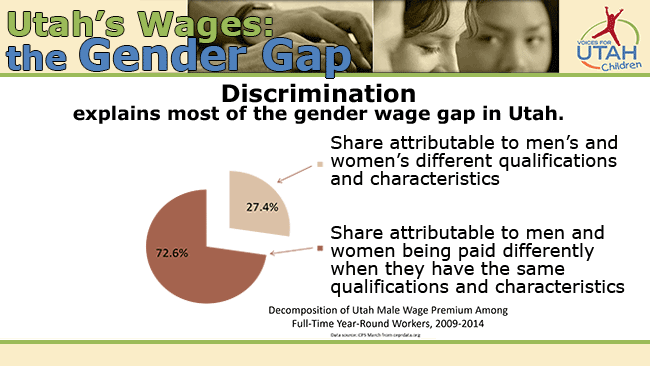
Breaking Down Utah’s Endowment Effect
This chart shows a breakdown of Utah’s endowment effect.
- In Utah, measurable differences between men and women in level of education, occupational choices, and industrial distribution make the wage gap larger.
- At the national and regional levels, industrial composition serves to make the wage gap larger, while education and occupational choice make the wage gap smaller.
In other words, education and occupational choice work in the opposite direction in Utah compared to the national or regional levels.
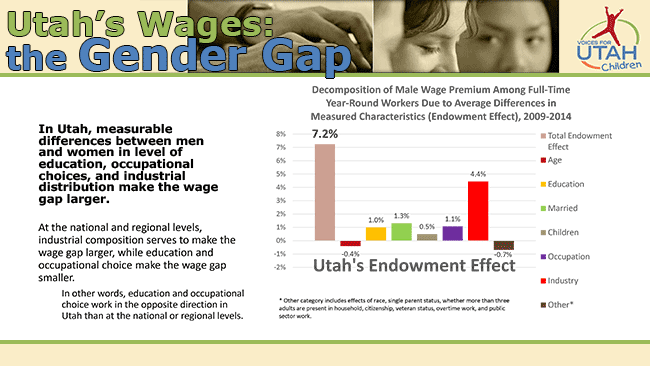
Why Is Utah Different?
Why does Utah have a larger wage gap than the nation or Utah’s neighbors?
Just as we decomposed the wage gaps, we can also decompose the difference between the wage gaps (Utah vs. its neighbors and Utah vs. the nation) into:
- A part we can attribute exclusively to differences in qualifications and measured attributes (“pure endowment effect”).
- A part we can attribute exclusively to differences in how men and women are paid (“pure returns effect” which is the part that includes discrimination).
- Interaction terms (omitted on the graph because they are small and not interesting on their own).
Decomposition of Wage Gap Differences
- Utah has a larger wage gap than either the nation or Utah’s neighbors.
- Utah has a larger wage gap mainly because of the endowment effect.
- Utah women are more disadvantaged due to education, occupation, and industrial distribution in Utah compared to women at the regional and national levels.
- The differences in the returns effect, which seeks to measure discrimination, do not appear to be statistically significant between Utah and the nation or between Utah and the Intermountain region.
Conclusion: Thus, while the returns effect, which is intended to measure discrimination, explains most of Utah’s gender wage gap, the endowment effect explains most of why Utah’s gap is so much worse than the nation’s.
Differences between men’s and women’s qualifications and characteristics explain over 90% of the difference between Utah’s wage gap and that of the nation.
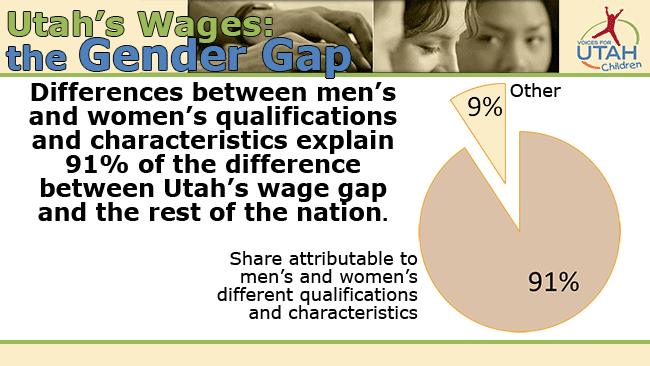
How Utah’s Gap Has Changed Over Time
We would like to know how Utah’s gap now compares to what it was a generation ago (2009-2014 vs. 1992-1997). We can separate the change into:
- A part we can attribute exclusively to changes in men’s and women’s measurable qualifications and characteristics (“pure endowment effect”.
- A part we can attribute exclusively to changes in how men and women are paid when their measurable qualifications and characteristics are equal (“pure returns effect”).
- Interaction terms (omitted on the graph because they are small and not interesting on their own).
Decomposition of Wage Gap Change Over Time
Here, negative numbers indicate an improvement in the wage gap over time.
Unlike the nation and the region, Utah has seen no improvement in its gender wage gap over the last generation.
- Utah has seen significant improvement in the returns effect over the past generation, more so than at the national and regional levels, indicating a diminishment in gender wage discrimination.
- However, that improvement in Utah was completely offset by the growing gap between men’s and women’s measurable qualifications and characteristics.
An Example:
How Men’s and Women’s Measurable Qualifications Have Changed Differently Over the Last Generation
United States vs. Utah, among full-time/year-round working men and women
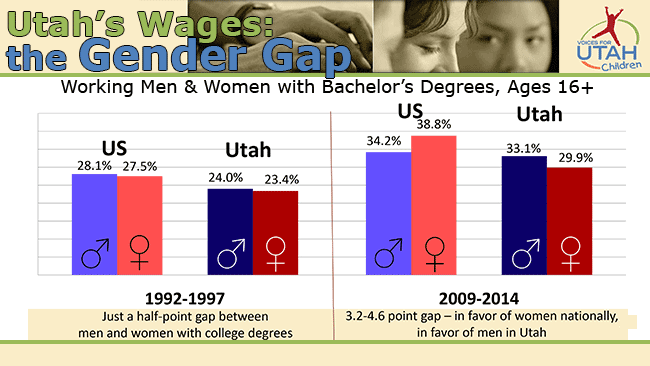
Policy Recommendations
- Pursue policies that seek to end direct wage discrimination.
- Investigate methods to improve women’s educational attainment and occupational and industrial distribution.
- Address workplace and other practices and policies that have a disparate impact on women by making it more difficult to balance work or education with family responsibilities.
- Pursue policies such as the Earned Income Tax Credit (EITC) that increase take-home pay at the lower wage levels, since women make up the majority of lower-wage workers.
Printer-friendly Report:
Explaining Utah's Gender Gap in Wages
The complete thesis which informed this report is available here: Explaining Utah's Gender Gap in Wages, Honors Thesis by Curtis Miller
The January 2015 report quantifying Utah's gender gap is available here: Utah's Gender Opportunity: An examination of the difference between the earnings of Utah men and women
For 30 years now, Voices for Utah Children has called on our state, federal and local leaders to put children’s needs first. But the work is not done. The children of 30 years ago now have children of their own. Too many of these children are growing up in poverty, without access to healthcare or quality educational opportunities.
How can you be involved?
Make a tax-deductible donation to Voices for Utah Children—or join our Network with a monthly donation of $20 or more. Network membership includes complimentary admission to Network events with food, socializing, and opportunity to meet child advocacy experts. And don't forget to join our listserv to stay informed!
We look forward to the future of Voices for Utah Children and we hope you will be a part of our next 30 years.
Special thanks to American Express for sponsoring our 30th Anniversary Year. 
The Earned Income Tax Credit is a federal tax credit for low- and moderate income families that encourages and rewards work. The credit was created in 1975 under President Ford. Because of its remarkable ability to reduce poverty and promote family health and self-sufficiency, it has been expanded since then by President Reagan and all subsequent presidents.
 For parents, the EITC’s empirically demonstrated effects include:
For parents, the EITC’s empirically demonstrated effects include:State EITCs Offset Regressive Effects of Income, Sales and Property Taxes
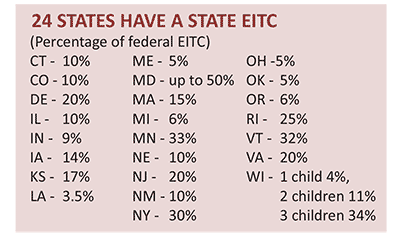 Twenty-four states have created state EITCs to supplement and enhance the impact of the federal program. State EITCs work similarly to and leverage the federal EITC. States rely
Twenty-four states have created state EITCs to supplement and enhance the impact of the federal program. State EITCs work similarly to and leverage the federal EITC. States relyAn Innovative Proposal: Using a State EITC to Promote College Savings and Incent Post-Secondary Education in Utah
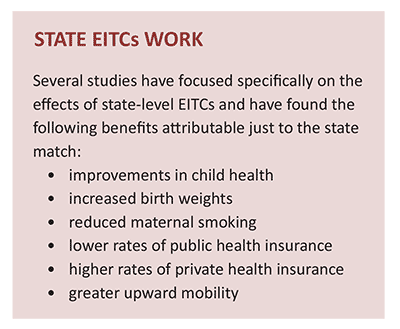 An innovative proposal under discussion for Utah combines two key elements proven to reduce intergenerational poverty:
An innovative proposal under discussion for Utah combines two key elements proven to reduce intergenerational poverty:
The EITC Has Bipartisan Support
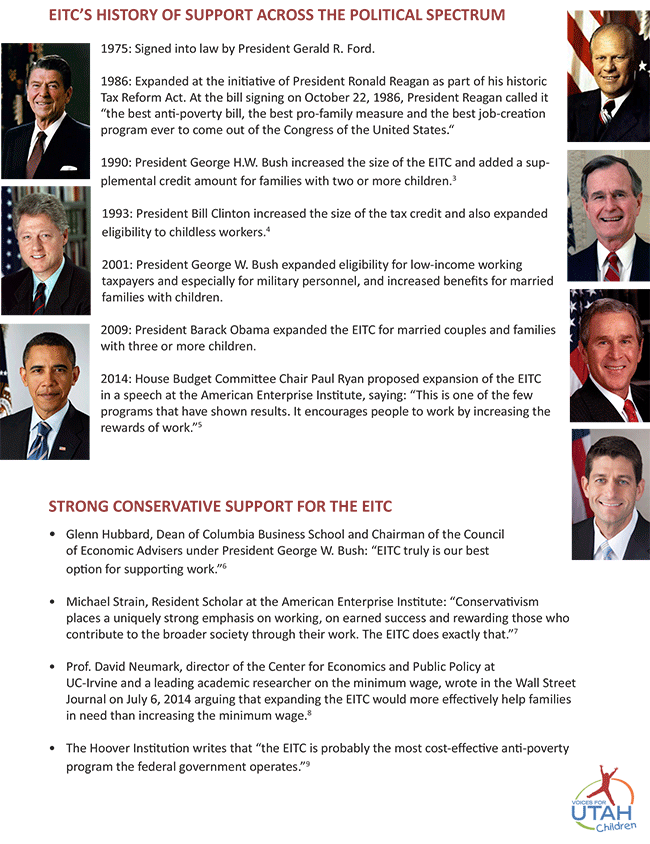
Federal EITC Facts for Utah
Read other issues briefs about two-generation strategies here.
Voices for Utah Children is proud to be a part of the Aspen Institute Ascend Network. The goal of the Aspen Institute Ascend Network is to mobilize empowered two-generation organizations and leaders to influence policy and practice changes that increase economic security, educational success, social capital, and health and well-being for children, parents, and their families. Learn more at http:/ /ascend.aspeninstitute.org/network
For 30 years now, Voices for Utah Children has called on our state, federal and local leaders to put children’s needs first. But the work is not done. The children of 30 years ago now have children of their own. Too many of these children are growing up in poverty, without access to healthcare or quality educational opportunities.
How can you be involved?
Make a tax-deductible donation to Voices for Utah Children—or join our Network with a monthly donation of $20 or more. Network membership includes complimentary admission to Network events with food, socializing, and opportunity to meet child advocacy experts. And don't forget to join our listserv to stay informed!
We look forward to the future of Voices for Utah Children and we hope you will be a part of our next 30 years.
Special thanks to American Express for sponsoring our 30th Anniversary Year. 

